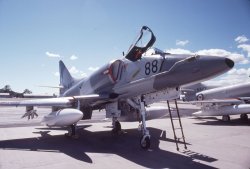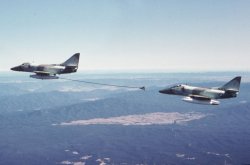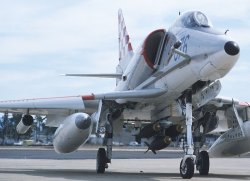‘Air Force Airlines’
33 SQN (October 1982 – May 1985)
On the evening of Friday, the 29th of October 1982, the sun was rapidly slipping toward the horizon behind us as our Ansett Airlines aircraft approached its descent point into Sydney. Although the flight from Perth had been a relatively short one (only around four hours), the nature of traveling eastwards, in opposition to the relative passage of the sun, meant that our flight that had left Perth at 11am local time was due to arrive at its destination at 6pm Sydney time. As I looked out the window and watched the changing hues of the darkening evening sky, it seemed somehow surreal that after nearly sixteen months of continuously moving ever further away from home, I was finally heading back to the east coast of Australia, and would soon be within a mere day’s drive of Kalbar. I reminded myself though, that from this time onward, I would have to emotionally redefine the concept of ‘home’ because, as a married man posted to his first operational squadron, Richmond (to the north-west of Sydney) would now be my home for at least several years. Up until this point in time, I had viewed myself simply as an itinerant trainee pilot with, at best, a questionable future; but now that my flight training was behind me, I could finally begin to contemplate what life would be like as a professional RAAF officer and pilot.
But the demoralizing conclusion to my training at Pearce had left me with some deep self-doubts. Just what had Bill E seen in my flying on that final day that had persuaded him to allow me to graduate and receive my RAAF Wings? ‘Wings Test Mk II’ (I just couldn’t bring myself to think of it as my ‘Wings Test Repeat’) wasn’t much better than ‘Wings Test Mk I’ and, after landing, I had fully expected to be told that I’d failed; therefore suffering the ultimate ignominy of being scrubbed on my very last flight. Instead, in what I considered to be a stroke of luck, or perhaps some divine intervention, Bill had decided to give me a Pass for what was really a very average flight. Quite frankly, despite all the months of unrelenting effort, I felt somewhat of a fraud whose future career came courtesy of a benevolent gesture rather than as the deserved reward for demonstrating proficient flying skills. I had come to think of myself as a ‘flying tradesman’ who had to work hard to get the job done, and while I envied the ‘craftsmen’, to whom flying was effortless second-nature, I knew that I could never hope to join their exalted ranks. But could a tradesman realistically expect to be able to fly a big, heavy four-engined jet like the Boeing 707?
I hadn’t even allowed myself to seriously ponder this question yet, because all of my efforts to date had been solely focussed on finishing Pilots Course. When my posting to 33 FLT had been announced at Pearce, many of the instructors had heartily congratulated me on my ‘plum posting’. I knew that no other Pilot Officer had ever been posted from 2FTS to fly 707s, but I was also now under no illusions that I had been singled out because of my exceptional flying skills. My instrument flying was undoubtedly better than my general flying because it dealt with concrete concepts where you tracked radials, calculated ranges and turning radiuses and configured the aircraft to meet predetermined altitudes, distances and airspeeds – you “flew by the numbers”. It was navigating the enormous, three-dimensional arena of general flight that gave me trouble. In this vast space, bounded only by the earth and the limitations of your machine, you were expected to be able to manoeuvre intuitively and fly stalls, spins and aerobatics “by the seat of your pants”; almost becoming a physical extension of the aircraft. So with this in mind, even though my submitted preference to fly 707s had been pretty much an afterthought, the posting to 33 FLT had probably been the best outcome that I could have wished for.
But as our aircraft dipped its nose and began its long descent into Sydney, I realized how little I actually knew about 33 FLT. Of course I knew that its role was VIP Transport for royalty, heads of state and politicians and that its Boeing 707s flew to airports all over the world; but I really knew little else. Later, it was explained to me anecdotally that Gough Whitlam, as Prime Minister, had come to an understanding with Qantas that when the airline’s 707s were decommissioned in the late 1970s, the RAAF would take delivery of two of them to serve as VIP transports. The Boeing 707 offered range, speed and comfort advantages far superior to any other VIP transport aircraft already in the RAAF inventory, plus there was the added attraction that the size of the aircraft would allow the incumbent Prime Minister to take some of his staff, as well as a large press contingent, along with him whenever he travelled overseas.
Unfortunately for Gough, he was dismissed from office long before the 707s were delivered, but his successor, Malcolm Fraser (who had apparently strenuously criticized the impending ego-driven purchase while in Opposition) decided to honour the commitment, with the first 707 entering RAAF service in 1979. His instruction to the Chief of Air Force Staff, however, was to “keep them away from Canberra” so as to minimize the exposure of the newly-acquired, extravagant VIP aircraft to the cynical Canberra press gallery. The RAAF Chief subsequently reasoned that, since the 707 was really just a glorified transport aircraft, it should be co-located with the other transport aircraft at RAAF Base Richmond. While Richmond’s seven thousand foot runway (sandwiched between Richmond to the west and Windsor to the east) would severely restrict the payload and range of the 707, at least the ‘new’ aircraft would be largely tucked away from public view. Since only two aircraft were to be purchased from Qantas, it was decided that the 707s should initially be operated as a Flight within 37 Squadron; an organization primarily focused on operating its large fleet of C130 Hercules cargo aircraft. However in February 1981, a greater degree of autonomy was granted to the 707 operation with the formation of the independent 33 FLT; that soon afterwards moved into its own headquarters building (located adjacent to the two Hercules squadron headquarters).
As our aircraft approached Sydney, I wondered what the 33 FLT pilots would be like. For such a responsible duty, surely these men would have to be amongst the most capable and professional aviators in the world. How would a newly-minted ‘Boggy’ Pilot Officer who had failed his first Wings Test possibly be able to establish himself and achieve some credibility in such an elite and experienced outfit? Although I ultimately aspired to captain a Qantas 747 (the much larger successor to the vaunted 707), I knew nothing about the operation of multi-engined aircraft and was, instead, more familiar with g-suits and helmets, ejection seats, oxygen masks and parachutes. I decided that I would just have to take things in stride, attempt to overcome my burgeoning feelings of self-doubt and tackle the upcoming conversion course one day at a time.
………
Wing Commander Dave G, the Commanding Officer of 33 FLT, was a lightly-built man of shortish stature, with thinning brown hair and a luxuriant, manicured moustache. I instantly pictured him perched nonchalantly in a little red convertible, winding his way through the English countryside, cravat flying in the breeze with a pipe clamped between his teeth as he rushed off to climb into his Spitfire and engage the vicious Hun. Even his speech reflected the clipped and polished tones that could be expected of the man charged with the responsibility for safely transporting the nation’s leader around the world. I saluted smartly and stood to attention. He told me to take off my hat, relax and take a seat.
“Geoff”, he said perplexedly, “I don’t really know what we’re going to do with you. We’re just going to have to make this up as we go along; but I should tell you that you certainly can’t expect to get a command here, and I don’t even know whether you’ll be able to sit in the front seat for takeoffs and landings.”
“Great”, I thought, “I’m going to be a paid passenger and not even be given a chance to fly the aircraft. I’ll just be a glorified radio operator!”
…….
"Settling In"
After a few days, I was called in to see Squadron Leader Peter ‘Woofy’ A, who was the Training Flight Commander, and also one of the two 707 QFIs. Woofy was also moustachioed and of a similar height to the CO, but he was of a slightly stockier build. Whenever he spoke, he had a twinkle in his eye and a perpetual half-smile; as if he was just about to tell a joke or was continually thinking about something amusing. While the CO seemed a bit standoffish and old-school, Woofy was gruff, no-nonsense and down-to-earth with a dry wit.
“What did the CO tell you about your conversion course?” he asked me straight away.
When I told him that the CO doubted that I would even be able to occupy one of the front seats after conversion (in whatever form that conversion course would take), Woofy said:
“Bulls**t! As far as I’m concerned, mate, you’ll get as far as you want to go, provided you put in the effort. I intend giving you exactly the same conversion program as the ‘retread’ on your course, and if you can handle the syllabus, I don’t see any reason why you shouldn’t do exactly the same job as the other squadron pilots.”
A ‘retread’, I soon learnt, was the generic RAAF-wide nickname given to a pilot who had been on previous operational postings. In effect, Woofy had told me that I would be given the same opportunities as any other new arrival to the squadron, and that what I achieved on my posting at 33 FLT would largely depend on my own degree of dedication.
……
"Conversion Course"
In mid-February, the conversion course kicked off, and while I went to work at the RAAF base, Tracy went to work in the house with every cleaning agent you can imagine to get things shipshape and to rejuvenate the rather flat-looking shagpile. Ground school was scheduled for the first month of the conversion course, and it would be followed soon after by two weeks of flight simulator training at the Cathay Pacific simulator complex in Hong Kong. Some conversion flying and an Instrument Rating Test back in Australia would complete the entire process by the end of May. It seemed a long time to be under training, but the prospect of a fortnight in Hong Kong was a very exciting one, particularly since my only overseas trip at that stage had been a family holiday to New Zealand in 1978. My course-mates consisted of only two people – Dave C (a retread Flight Lieutenant pilot) and Charlie B (a flight engineer) both of whom had been posted in from a Hercules squadron. Right from the outset, I realized that 707 systems lectures were my kind of ground training.
At Point Cook and Pearce, we had been taught about the aircraft systems by “chalk-and-talk”, but the 707 systems were explained by flight engineers using colour slides and schematic diagrams that had been sourced from Qantas. Since there were so many systems on the 707, the level of detail provided on each system was scant – just how I liked it. Instead of “this flange drives this rocker assembly that then opens this valve electro-mechanically to provide bleed air”, a 707 system would be explained to us something like this:
“Using rate gyros, the yaw damper computer senses aircraft oscillations in yaw at altitude, which is referred to as ‘Dutch Roll’. Via a servo, the computer then provides inputs to the rudder to cancel out the Dutch Roll”.
One of us might then ask, “Okay, but how does the computer do that?”
To which the instructor would reply, “Using rate gyros, the yaw damper computer senses aircraft oscillations in yaw at altitude. Via a servo, the computer then provides inputs to the rudder to cancel out the Dutch Roll. Got it now?”
“Yes”, we would mumble, unconvinced, “but what if the computer fails?”
“You put in the spare computer”, the instructor would say. “Any other questions, because we really have to move on”.
It wasn’t that the instructor didn’t know the answer – our instructors had a lot of experience on the aircraft and knew it intimately – it was just that on this aircraft, and in this squadron, there was a culture that as far as aircraft systems knowledge went, you were only taught what you really needed to know to be able to operate the aircraft safely. In the training slide packages, regularly-spaced review questions (utilizing A, B, C or D multi-choice options) were used to consolidate the subject matter. I just lapped it up and felt sorry for some of the guys on the base that I heard discussing their Hercules conversions, where they had to learn the names of the sixty-four circuit positions on the coughpit circuit breaker board, in order and by rote.
…..
After a few weeks of learning the systems on the 707, we were taught “Aircraft Performance”; that involved examining a multitude of graphs to determine power settings and speeds for takeoff, landing, cruise, holding and every other imaginable type of aerial situation. This was all new to me, of course, but as long as you didn’t ask why there was a kink on a graph at a certain point, or why the line was straight in some situations, but curved in others, performance wasn’t too bad. The ground school component of our conversion course was eventually concluded by sitting in an aircraft out on the flight line, and running through the extensive preflight check that was conducted by the co-pilot in the right-hand seat for every flight. There was then a gap of a few weeks between the end of ground school and the commencement of the simulator training and I used this time to make notes on the various flying sequences that we would be practicing in the simulator.
…..
Our simulator training phase quickly settled into a routine. The other squadron pilots would also transit through Hong Kong over the next two weeks for their six-monthly emergency checks, so the conversion course was usually assigned four-hour morning sessions, and the other pilots were allocated four-hour afternoon sessions. We met our instructors each morning in the foyer at around 7:30am and then travelled to the Cathay simulator building (out near Kai Tak Airport) by taxi. The session would start at 9am and finish by 1pm, at which time we would take a taxi back to the hotel and then use the afternoon to prepare for the next session (if we had one coming up the next day). A couple of spare days were built into the program to give us a break from what was a fairly steep learning curve … especially for me.
…..
The 707 simulator was a large white box mounted atop three large, hydraulic jacks that moved in accordance with the flying pilot’s inputs to tilt the box in various directions and replicate the motion of an aircraft to the people sitting inside it. The only thing that the ‘box’ could not replicate was the ‘g’ force that occurred when the pilot pulled back on the controls. The interior of the box contained coughpit controls and instruments for the pilots and flight engineer that were very similar to those in our own 707s, and there was a large panel of red and green buttons at the back of the box that the instructors pushed to introduce various system or engine malfunctions. Two large television screens mounted outside the pilots’ stations displayed runway lighting and peripheral environmental lighting so that trainees felt that they really were flying into and out of various airports at night. A massive computer in an adjacent room controlled the movement of the hydraulic jacks, the flight instruments and the generation of the images on the television screens. When the ‘box’ was in motion, for all intents and purposes, you really were flying a 707 aircraft at night.
During the first nine simulator sessions – the tenth would be our check ride – Dave C and I alternated as the Flying Pilot to learn the various procedures that were required to be mastered to become an operational 707 pilot. Broadly speaking, the sessions were usually broken down into engine start malfunctions and rejected takeoff procedures before our fifteen-minute coffee break, and then inflight engine or system malfunctions for the remainder of the session. Some emergency procedures required us to manipulate various controls and carry out numerous checklist actions from memory, while other situations required us to troubleshoot and analyse the problem as a crew, before then systematically working our way through a series of emergency checklists. After the first few largely introductory sessions, we started learning the more advanced engine failure procedures, which was all new territory, of course, for me.
With the aircraft in flight, the instructor pushed a button that made one of the engines catch on fire (accompanied by a loud fire warning bell) or fail completely with a subsequent loss of thrust from the failed engine. Following an engine flameout or power loss in flight, the first thing that the flying pilot might notice is the requirement to bank the aircraft in the direction of the ‘live’ engines to maintain a constant heading. But to maintain manoeuvrability, the flying pilot then has to quickly introduce rudder in the same direction as the initial yoke displacement (while simultaneously centralizing the yoke), so that the full range of aileron travel can still be applied, if required. It is a skill that requires a bit of practice, particularly when every subsequent change in thrust on the remaining engines requires a re-adjustment of the yoke and rudder positions. With practice though, once the initial rudder input has been made, it’s possible to intuitively adjust the rudder as the thrust levers are advanced or retarded. However, despite the rudder being a hydraulically-boosted control surface, the muscle strain of holding in the rudder input (which required a surprising amount of force) usually made my leg start to tremble and shake after about ten minutes. At the conclusion of one particularly lengthy engine-out sequence, my leg almost collapsed from under me as I climbed down the ladder to head to the coffee room for debriefing.
When we could competently manage engine-out flight, we learnt how to handle engine failures during the takeoff roll where, depending on the speed at which the failure occurred, either a rejected takeoff procedure or an engine failure after takeoff procedure would be required. Since the simulator belonged to Cathay Pacific, most of our sessions were conducted at Hong Kong airport, where the surrounding mountainous terrain made the procedures even more demanding. The ‘twitchiness’ of the simulator in pitch also apparently made the simulator quite difficult to fly, but because it was all I knew, I adjusted, and was told that if I could fly the simulator well, I would certainly have no trouble flying the aircraft.
Eventually the day of the check ride came around, but despite some nerves, the session was fairly straight forward because Woofy, our instructor, was very laidback, and the check consisted of carrying out procedures that we had been practicing every day for nearly a fortnight.
We flew home on board one of our own 707 aircraft that had been flown up to Hong Kong by the last few guys who had been programmed to carry out their emergency checks. Woofy was the captain, Dave C sat in the right-hand seat and I sat in the observer’s seat, behind Woofy. It was amazing to be sitting in the coughpit of the actual aircraft and see the systems working for real – I just couldn’t wait for my turn to fly it!
That chance came just a week later when we started a series of conversion flights that encompassed circuits and instrument approaches at nearly every Australian RAAF base including Pearce.
The aircraft certainly felt much more stable in pitch than the simulator had been, but given that the rudder was the only hydraulically powered control surface and that the elevator and ailerons operated through cables, pullies and bell-cranks, it certainly took manful control inputs to drive the big machine around the skies. The 707 had also gained a reputation as being quite a difficult aircraft to land (which I discovered for myself several times over the years), but my first landing attempt must have been reasonable, because looking back, I have no clear recollection of where it was or how it went.
Circuits at Avalon in Victoria, however, were a particular challenge, because it seemed that whenever we were there, the wind was blowing from the west: straight across the long north-south runway. The landing crosswind limit for a Boeing 707 was 23 knots of steady wind, with allowable gusts of up to 28 knots and this limitation must have been known by the tower controllers, because whenever we asked them for a wind check (usually with the thirty knot windsock standing straight out and perpendicular to the runway), the controller would instantly respond with, “crosswind of 23 knots, gusting 28 knots”. On final approach in those sorts of winds, it wasn’t unusual to have as much as fifteen degrees of drift, and it sometimes felt like you were actually approaching the runway sideways. I often found myself subconsciously twisting around in the seat, so that the visual orientation of the runway environment seemed more normal.
Landing the 707 in such strong crosswinds required keeping the drift on right up until the flare at about twenty feet above the ground. Then, as the thrust levers were retarded to idle, left or right rudder (depending on the direction of the crosswind) had to be promptly introduced to align the aircraft with the runway centreline, while opposite aileron was fed in to keep the wings level. The engine pods that were slung under the 707 wing were surprisingly close to the ground, and if a landing was mishandled in strong crosswinds and a level attitude was not maintained, it was easily possible for the engine pods on the lower wing to scrape along the runway surface. Flying an hour of circuits in strong crosswind conditions was certainly a workout, and I was greatly relieved that we flew the 707 wearing our RAAF blue uniforms, rather than in the hot and stuffy Nomex flying suits that were worn by RAAF pilots in nearly every other squadron.
Eventually, after nearly a month of flying the aircraft all around the country, my training concluded with the successful completion of an Instrument Rating Test that was mostly conducted at Canberra. Again, there was none of the stress and angst of earlier flight tests at Point Cook and Pearce, and I felt that I may have finally found my ‘home’ on the big four-engined jet. Now I was ready and rearing to go on some of those exciting overseas trips that I saw appearing regularly on the big tasking board in the Operations Room.
To be continued....

























